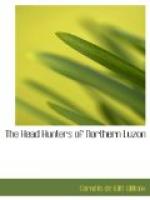[11] According to the native legend, this mountain used to form part of the Zambales range. It became, however, by reason of its quarrelsome disposition, so objectionable to its neighbors of this range, that they finally resolved no longer to endure its cantankerousness and accordingly banished it to its present position in the plain of Central Luzon, where it would have no neighbors to annoy, and where it has stood ever since, rising solitary from the surrounding plain.
[12] Dr. Barrows, in the “Census of the Philippine Islands,” Vol. I., p 471, says that the etymology of this word is unknown. As it seems to mean “people of the mountains,” it is not unlikely to be a form of “Igolot,” by metathesis, as it were.
[13] According to some accounts, the Highlanders, in throwing the spear, give it a rotation around its longest axis, twirling it rapidly in the hand as this is brought up before the throw. In other words, they have discovered that a rotating spear has greater accuracy than a non-rotating one. If this is true, this discovery is worthy to be bracketed with the use of the fire-syringe by the Tinguians of the North, and by certain other wild people of the Archipelago.
[14] These salt deposits are now (1912), to the great satisfaction of the people of the province, being worked by the Government, and salt has ceased to be a luxury within the reach of only the few rich.
[15] The Ilongots are so few in number and scattered over so vast and rough a country that trail-making can never be as successful in their territory as it has been farther north.
[16] Dampier’s description of what he saw in Mindanao fits here: “This Distemper runs with a dry Scurf all over their Bodies, and causeth great itching in those that have it, making them frequently scratch and scrub themselves, which raiseth the outer skin in small whitish flakes, like the scales of little Fish, when they are raised on end with a Knife. This makes their skin extraordinary rough, and in some you shall see broad white spots in several parts of their Body. I judge such have had it, but are cured; for their skins were smooth, and I did not perceive them to scrub themselves: yet I have learnt from their own mouths that these spots were from this Distemper.”—Dampier’s “Voyages,” Masefield’s edition, p. 341; New York, E. P. Dutton & Co., 1906.
[17] On one of his first expeditions elsewhere, however, when the women realized that they were really to receive gifts of beads, etc., they rushed Mr. Worcester and his assistants, upsetting them all in their eagerness to get at the stuff.
[18] So Strong said, himself an accomplished violinist.
[19] The straw mat covering the “split bottom” of the native bed. There is no other mattress, and the “split bottom” constitutes the springs. Once accustomed to it, the bed is cool and comfortable.
[20] Dampier’s “Voyages,” p. 319, Masefield’s edition.




